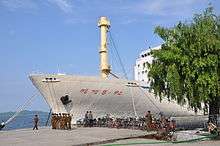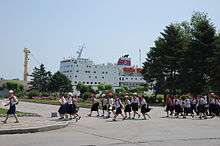Mangyongbong-92
 Mangyongbong-92 at Wonsan in 2010 | |
| Korean name | |
|---|---|
| Chosŏn'gŭl | 만경봉 92호 |
| Hancha | 萬景峰 92號 |
| Revised Romanization | Man-gyeongbong 92(gusibi)-ho |
| McCune–Reischauer | Man'gyŏngbong kusibi ho |
| History | |
| Name: | Mangyongbong-92 |
| Route: | Wonsan-Niigata (until 2006), Rason-Mount Kumgang (2011) |
| Launched: | 1992 |
| Out of service: | 2013 |
| Identification: |
|
| Status: | anchored in Wonsan |
| General characteristics | |
| Type: | Ro-Ro/passenger ship[1] |
| Tonnage: | |
| Length: | 162.1 m |
| Beam: | 20.5 m |
| Speed: | 23 knots |
| Capacity: | 200 passengers and 1,000 tons of cargo |
Mangyongbong-92 is a cargo-passenger ferry, named after a hill near Pyongyang. The ferry was built in 1992 with funds from Chongryon, the pro-Pyongyang General Association of Korean Residents in Japan, and was used to transport passengers and cargo between North Korea and Japan.[2] These voyages continued until 2006 when Japan banned North Korean ships from its waters.[3] In 2011 the ship trialed a route between Rason and Mount Kumgang. As of 2015, the ship operates no route and is anchored in Wonsan.

Background
The first Mangyongbong ship had its maiden voyage in September 1971, amidst Japan’s easing restrictions on visits to North Korea by Zainichi Koreans. It was used to transport people between North Korea and Japan until it was replaced by the Mangyongbong-92 in 1992.[4] The Mangyongbong-92 was constructed using a donation of 4 billion yen (approximately US $32 million) from Chongryon to North Korea as a gift for Kim Il-sung’s 80th birthday.[2]
The ferry can carry 200 passengers and 1,000 tons of cargo. Prior to the Japanese ban on North Korean vessels, it made about 1 to 2 round trips per month between Niigata, Japan and Wonsan, North Korea, with a one-way trip lasting about 28 hours.[2] Most of the passengers were North Korean zainichi visiting relatives or students of a Chongryon school on a study trip. The cargo was typically electronics, medical devices, and other manufactured products.[2] In August 1993, a first-class ticket on the Mangyongbong-92 would cost about US $1,500 each.[5]
Controversy with Japan
In September 2002, the North Korean government admitted to abducting several Japanese citizens throughout the late 1970s and early 1980s.[6] This admission caused people to believe the first Mangyongbong, operating since 1971, was used to transport these abductees to North Korea.[7] This assumption sparked further suspicion surrounding the ferry’s successor, the Mangyongbong-92, that was still in operation.[8]
The main allegation against the Mangyongbong-92 was that it allowed the smuggling of illegal items to and from Japan. Specifically, it was believed that drugs and weapons were being smuggled into Japan, and cash, missile parts, and other potentially dangerous technology were secretly being taken to North Korea.[3][7]
These suspicions were supported by several confessions made in 2003 by former North Korean citizens and allies. In late January 2003, Kim Sang Gyu, a former senior official of Chongryon, admitted to running an espionage network in Japan for North Korea until 2000. He confessed to receiving his orders from Pyongyang through various high-ranking crew members aboard the Mangyongbong-92.[2]
On May 20, 2003, a former North Korean missile scientist testified at a U.S. Senate hearing that the Mangyongbong-92 transported 90% of the missile parts used by North Korea.[2] These components were suspected of having been obtained from typical Japanese electronics such as game consoles and digital cameras, which would also make them easier to smuggle out of the country.[3]
In August 2003, the Yomiuri Shinbun reported that a North Korean defector confessed to smuggling drugs for North Korea into Japan through the Mangyongbong-92. He would deliver these drugs to a member of Chongryon, who would then deliver the drugs to the Japanese yakuza. This confession supported the U.S. State Department testimonies made in May of that year, that North Korea’s methamphetamine market in Japan provided the government with a profit of up to US $7 billion.[6]
These allegations were denied by both the North Korean government and the head of Chongryon's foreign affairs bureau, So Chung-on.[8] While there was not enough evidence to support these allegations, that didn’t stop Japanese suspicions. Since the abduction admission, Japan began a stricter enforcement of regulations on North Korean vessels, especially the Mangyongbong-92.[6] In one instance, the threat of a thorough inspection supposedly caused the Mangyongbong-92 to remain in North Korea and to cancel its voyage, one that was to be the first to Japan in five months.[9]
Japanese ban
On July 5, 2006, North Korea launched seven missiles, one of which was a long-range Taepodong-2 missile capable of reaching Alaska. While all missile landed in the Sea of Japan (East Sea), Japan responded by banning the Mangyongbong-92 from Japanese waters for six months.[3][10]
In early October 2006, this ban became permanent and was imposed on all North Korean vessels, following North Korea’s suspected involvement in nuclear tests.[3]
Implementation for tourism
With the Mangyongbong-92 no longer able to make its intended trip to Japan, North Korea refurbished the ferry to serve as a cruise ship. The Mangyongbong-92’s new route traveled along the east coast of North Korea between Rason, in the northeast, and Mount Kumgang, near the South Korean border. The purpose of this cruise was to boost North Korea’s tourism, the one industry that is exempt from United Nations economic sanctions.[11] The tourists would meet in Yanji, China and drive three hours to Rason, North Korea. The Mangyongbong-92 would take them to Mount Kumgang, a scenic tourist destination complete with beaches and a golf resort. This area was jointly operated by North and South Korea until the fatal shooting of a South Korean tourist by a North Korean soldier in 2008, upon which all South Korean property was seized by the North.[12]
The trial run of the cruise took place in late August 2011. Much of the approximately 200 passengers were travel agents, media, and North Korean officials, with some paying about US $470 for the 5-day trip on both land and sea.[12] The trip south to Mount Kumgang took about 21 hours while the trip back took about 22 hours.[11] In contrast to the lavish send-off the ship received in Rason, the passengers were cramped into bedrooms and were assigned either a wooden bunk bed or a mattress on the floor. Meals were also simple and served “cafeteria-style”.[12]
In February 2013, North Korea reported replacing the Mangyonbong-92 with the Singapore cruise ship called the Royale Star.[13] Since then, satellite images have placed the Mangyonbong-92 in Wonsan Harbor.[14]
Current status
In September 2014, North Korea was expected to send a report to Japan that addressed the fate of the 1970s-1980s abductees. In August, though, the country made further requests for Japan to ease sanctions and provide further humanitarian aid in return for the report. These requests are suspected to be aimed at the allowance of the Mangyongbong-92 into Japanese waters.[15]
In March 2015, Japan continued to apply sanctions against North Korea when no further reports are made regarding the abductees, leaving the Mangyongbong-92 anchored in Wonsan.[16]
Significance
As the primary connection between North Korea and Japan, the Mangyongbong-92 was extremely important to North Koreans living in Japan. For many, it offered the only contact with family members residing in North Korea. During the late 1950s and early 1960s, there was a mass repatriation of Zainichi from Japan to the seemingly rich and prosperous North Korea. While this movement began to die down soon afterwards, over 93,000 Koreans and about 6,000 Japanese moved to North Korea between 1959 and 1984, each of them forced to remain there due to North Korea’s strict laws. As a result, this separation became a convenient way for North Korea to maintain the loyalty from repatriated citizens’ family members in Japan. Nevertheless, both the first Mangyongbong and the Mangyongbong-92 offered a connection between families that were commonly separated from this movement.[2]
The Mangyongbong-92 was also extremely important to Chongryon as it brought them money and gifts from the North Korean government. The presence of Chongryon and the Mangyongbong-92, though, was perceived as a threat towards the Japanese by having the “enemy” in their own backyard. In response, political moves, such as the creation of the NARKN, have taken place. Social changes have occurred as well where Koreans, particular students at Chongryon schools, are harassed. And suspicions of North Korean ploys, like those regarding the Mangyongbong-92 smugglings, would only increase the intensity of this behavior.[2]
Specifications
- Weight: 9,672 tons
- Length: 162.1 m
- Width: 20.5 m
- Speed: 23 knots
- Capacity: 200 passengers and 1,000 tons of cargo
References
- 1 2 3 4 "MAN GYONG BONG 92 - Ro-Ro/Passenger Ship". Marinetraffic.com. Retrieved April 24, 2015.
- 1 2 3 4 5 6 7 8 9 Shipper, Apichai W. (2010). "Nationalisms of and against Zainichi Koreans in Japan". The Washington Times.
- 1 2 3 4 5 "Ferry ban turns tide on Korean smuggling". The Washington Times. 2006-10-16. Retrieved 2015-04-15.
- ↑ http://japanfocus.org/-Tessa-Morris_Suzuki/3241
- ↑ "Food Riotsspreading,Travellersreport: FINAL Edition." The Vancouver Sun: A.8. 1993.
- 1 2 3 4 http://www.ncnk.org/resources/publications/CRS_Chosen_Soren_2003_RL32137.pdf
- 1 2 "Sailing Across A Sea Of Trouble." J@Pan Inc 48 (2003): 6-7. Business Source Complete. Web. 16 Apr. 2015.
- 1 2 Buckley, Sarah (2003-06-09). "N Korea ferry struggling against the tide". BBC News. Retrieved 2010-06-15.
- ↑ "Mangyongbong Issue Not to Affect Multilateral Talks: Fukuda." Jiji Press English News Service: 1. 2003.
- ↑ "Seventh missile launched: report". Sydney Morning Herald. 2006-07-04.
- 1 2 Wong, Edward (2011-09-13). "North Korean Cruise Seeks Tourists, 8 to a Room". The New York Times. Retrieved 2015-04-15.
- 1 2 3 Olesen, Alexa (2011-08-31). "North Korea, snubbing South Korea, launches tours in China". The Washington Times. Retrieved 2015-04-15.
- ↑ "North Korea Trying to Attract Foreign Tourists". NK Briefs. 2013-02-27. Retrieved 2015-04-15.
- ↑ "Mangyongbong 92 to be put to use in Rason for tourism". North Korean Economy Watch. 2011-08-31. Retrieved 2015-04-15.
- ↑ Richards, Clint (2014-08-15). "Pyongyang’s New Demands Could Derail Japanese Abductee Negotiations". The Diplomat. Retrieved 2015-04-15.
- ↑ Takahashi, Maiko (2015-03-30). "Pyongyang’s New Demands Could Derail Japanese Abductee Negotiations". Bloomberg Business. Retrieved 2015-04-15.
- ↑ "Mangyongbong 92, A North Korean Ferry". InterQ, a subsidiary of GMO Internet Group LLC. 2001-08-04.
- Mangyongbong-92 banned indefinitely from Japanese waters due to smuggling.
- Google Earth images of the Mangyongbong-92 docked in Wonsan harbor.